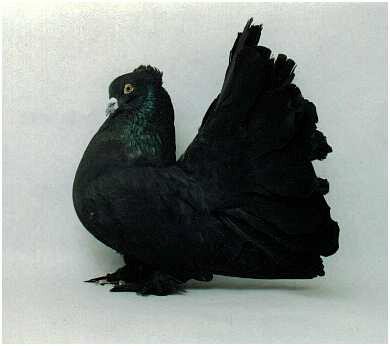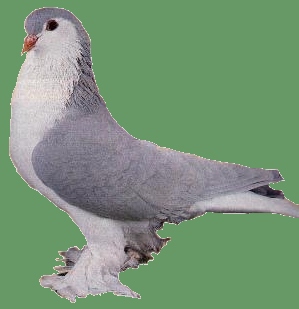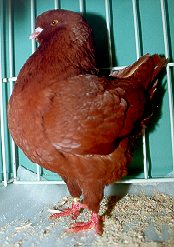 SPREAD
SPREAD 
While Spread is an extremely common mutation among domestic pigeons, it’s almost unknown under its genetic designation. Instead, pigeon fanciers call the effects this mutation produces self brown, black or “barless” mealy. (Some show pigeon fanciers call Ash-red Spread-- Strawberry -- especially if sooty is also included in the phenotype) Yet, no matter the fancier's name for it, each of these colors is merely an example of Spread on a different base pigment, brown, blue and Ash-red. Almost sixty years ago, W.F. Hollander noted that the pigment which provides the coloring matter in our birds’ plumage, came in two different arrangements. In the bars, pigment was spread out. In the rest of the feather it was clumped.You can imagine this pigment as a batch of spaghetti. In the area of the bars, the spaghetti is laid out regularly and spaced into individual strands. In the rest of the feather, it’s gathered together into small bundles. Each bundle is then laid in a regular arrangement. The color we see in any individual feather is a result of light hitting that feather and bouncing back to our retina. Where the pigment is spread out (the bars) almost all the light is absorbed and very little of it bounces back to our eye. We see black. Where the pigment is clumped, more light is bounced back to us and we see a blue-gray color. This pigment arrangement is the normal situation in the wild-type (blue bar) pigeon. Spread, however, is a mutation which upsets this normal arrangement. Somehow, it opens up the clumped pigment bundles and places the individual strands of pigment throughout the whole feather. What was once the normal situation only in the bars is now the situation throughout all the feathers. In fact, you can think of Spread as being a mutation which takes the tail bar color and paints it over the whole pigeon. Want to know what color bird you’re likely to get if you add Spread to it? It’s easy to imagine.
Look at a pigeon. Birds in the blue series, i.e., blue barless, blue bar or blue check, all have a black tail bar. Adding Spread to any such pigeon takes that tail bar color and paints it all over the bird. You get a black. In like manner, a brown with Spread becomes a self-brown. The dark brown color of the tail bar is spread all over the bird. Ash-red birds are a bit trickier. Not because the mutation does anything different with Ash-red, but because in Ash-reds, the tail bar is lighter instead of darker than the rest of the feather. When Spread is added to Ash-red, this lighter, ashy color is spread over the whole bird. Instead of a dark-red bird, which we might intuitively expect, we get an ashy-gray one. We get what many racing pigeon fanciers call a “barless” mealy. The bird is usually not actually barless. Barless is a totally different mutation found in the pattern series. In these so-called barless mealies, the bars are simply not seen under the Spread ‘overcoat’. It’s similar to what we see with blacks. We normally can’t see the bars under the Spread on those birds either.
1) The Modena (left) is NOT spread. It's recessive red. Actually, I shouldn't be so didactic about it not being spread, it MAY be underneath that red color. Recessive red is epistatic to spread. 
2) The King (right) IS spread Ash-red.Have a loft full of blues and blue checks and want some blacks? It's easy to add Spread to your stud? Just get a black pigeon. Mate it to any bird you’d like - one of the opposite sex usually works best. Since Spread is inherited as a simple dominant mutation and is not sex-linked, some of the youngsters in the nest will be Spread (blacks). If the bird you started with is heterozygous for Spread -- is carrying only one gene for Spread -- about half of your youngsters, in both sexes, will be spreads. If your original bird was homozygous for Spread -- carrying two genes for it -- all your youngsters of either sex will be Spreads. Spread inherits independently of the patterns (barless, bar, check), so each Spread bird also has one of those patterns underneath the Spread.
Therefore, any particular black pigeon is either a barless, barred or checked pigeon. If the black is a “good” black, shiny and dark, only breeding tests (or knowing the parents) will allow us to determine which pattern is hidden by the Spread "overcoat. If you happen to have brown bars or ash-red bars and want spread birds in those pigments, it'd be easiest if you could find a spread bird in those pigments, i.e., a self brown or a spread ash-red (under any of its fancier names). By getting a bird already in the pigment series you're working with, you don't have to worry about the sex-linkage of the pigment series. Of course, you can use any spread bird to introduce the mutation to your stud, though you might have to wait for the segregation of the genotype and phenotype you're looking for. But then, that's often part of the fun of breeding.
Copyright 1997 by Frank Mosca. This work may be downloaded or copied for non-commercial individual use only. All other rights under copyright are retained by the author. (Last updated 01/26/01)